In the ever-evolving landscape of cybersecurity, hiring the right talent is crucial for safeguarding your organization's digital assets. Crafting effective interview questions is key to identifying candidates with the skills required to protect against sophisticated cyber threats.
This comprehensive guide provides a curated list of cyber security interview questions, ranging from basic to advanced, to help you assess candidates at various experience levels. We cover essential topics including threat mitigation, network security protocols, and situational scenarios to evaluate analytical thinking.
By using these questions, you'll be better equipped to identify top cyber security talent for your organization. Consider complementing your interview process with a cyber security assessment test to gain a more holistic view of candidates' capabilities.
Table of contents
16 basic Cyber Security interview questions and answers to assess candidates

To evaluate your candidates' foundational knowledge in cyber security, use these basic interview questions. They will help you understand their grasp of essential concepts and their readiness for roles like a Cyber Security Analyst.
- What is the difference between a virus and a worm?
- Can you explain what multi-factor authentication is and why it is important?
- What does the acronym VPN stand for and how does it enhance security?
- Describe what a firewall does in a network.
- What is encryption, and why is it essential in cyber security?
- Can you explain what a DDoS attack is and how it impacts a business?
- What is the principle of least privilege, and how does it apply to user access?
- What are some common types of phishing attacks?
- What steps would you take if you discovered a security breach?
- What is the role of an Intrusion Detection System (IDS)?
- Can you explain the concept of 'defense in depth'?
- What are some key indicators of a potential security threat?
- What is social engineering and why is it a concern in cyber security?
- How do you stay updated on the latest security threats?
- What is the importance of regular software updates and patch management?
- Can you describe what a security audit entails?
8 Cyber Security interview questions and answers to evaluate junior analysts
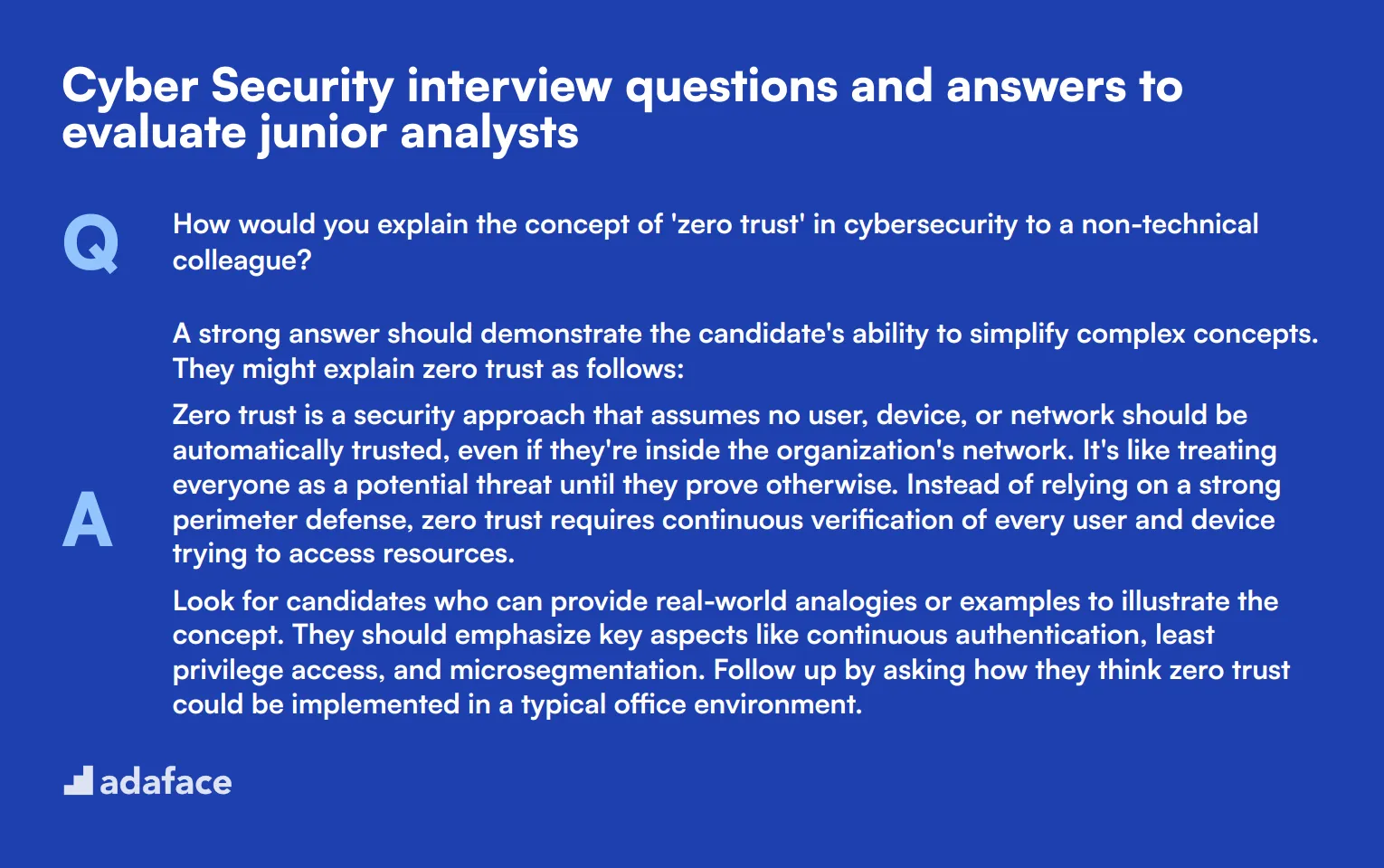
Ready to put your junior cyber security analysts to the test? These carefully crafted questions will help you assess their foundational knowledge and problem-solving skills. Remember, the goal isn't to stump them, but to gauge their understanding and potential. Use these questions as a springboard for deeper discussions about cyber security practices and challenges.
1. How would you explain the concept of 'zero trust' in cybersecurity to a non-technical colleague?
A strong answer should demonstrate the candidate's ability to simplify complex concepts. They might explain zero trust as follows:
Zero trust is a security approach that assumes no user, device, or network should be automatically trusted, even if they're inside the organization's network. It's like treating everyone as a potential threat until they prove otherwise. Instead of relying on a strong perimeter defense, zero trust requires continuous verification of every user and device trying to access resources.
Look for candidates who can provide real-world analogies or examples to illustrate the concept. They should emphasize key aspects like continuous authentication, least privilege access, and microsegmentation. Follow up by asking how they think zero trust could be implemented in a typical office environment.
2. What steps would you take to secure a newly set up Windows 10 workstation?
An ideal response should cover basic security measures and demonstrate a methodical approach. A good candidate might outline steps such as:
- Updating the operating system and all software to the latest versions
- Installing and configuring antivirus software
- Enabling the built-in Windows firewall
- Setting up user accounts with appropriate permissions (avoiding admin accounts for daily use)
- Encrypting the hard drive using BitLocker
- Disabling unnecessary services and features
- Configuring automatic updates
- Setting up a backup solution
Pay attention to candidates who mention the importance of creating a baseline for future comparison or those who discuss the need for ongoing maintenance. Consider asking follow-up questions about specific tools or techniques they would use for each step.
3. Can you explain the difference between symmetric and asymmetric encryption?
A solid answer should clearly differentiate between the two types of encryption:
Symmetric encryption uses a single key for both encryption and decryption. It's faster and efficient for large amounts of data, but key distribution can be challenging. Examples include AES and DES.
Asymmetric encryption uses a pair of keys: a public key for encryption and a private key for decryption. It's slower but solves the key distribution problem and enables digital signatures. RSA and ECC are common examples.
Look for candidates who can explain the pros and cons of each method and provide real-world use cases. For instance, they might mention that symmetric encryption is often used for bulk data encryption, while asymmetric is used for secure key exchange or digital signatures. Consider asking how they would choose between the two for different scenarios.
4. How would you go about investigating a potential data breach?
A strong response should outline a structured approach to incident response. Key steps might include:
- Initial assessment and containment: Identify the scope and impact of the breach, isolate affected systems.
- Evidence collection: Gather logs, network traffic data, and other relevant information.
- Analysis: Examine the collected data to determine the breach's cause, extent, and potential impact.
- Remediation: Address the vulnerability that led to the breach and strengthen defenses.
- Reporting: Document findings and actions taken, prepare reports for management and relevant authorities.
- Post-incident review: Conduct a lessons-learned session to improve future responses.
Look for candidates who emphasize the importance of having an incident response plan in place before a breach occurs. They should also mention the need for clear communication throughout the process and the potential involvement of legal and PR teams. Consider asking about specific tools or techniques they would use in each phase of the investigation.
5. What is the OWASP Top 10, and why is it important for web application security?
A good answer should demonstrate familiarity with this crucial resource in web application security:
The OWASP (Open Web Application Security Project) Top 10 is a regularly updated list of the most critical web application security risks. It includes vulnerabilities like injection flaws, broken authentication, and sensitive data exposure. The list is based on data from security firms and over 500,000 applications.
Look for candidates who can explain why the OWASP Top 10 is important: it provides a starting point for web application security, helps prioritize security efforts, and serves as a standard awareness document for developers and security professionals. They might also mention that it's often used in compliance requirements. Consider asking them to elaborate on one or two items from the current list and how they would mitigate those risks.
6. How would you explain the concept of 'defense in depth' to a non-technical manager?
An effective answer should demonstrate the ability to communicate complex security concepts in simple terms:
Defense in depth is like securing a castle. Instead of relying on just a strong outer wall, you have multiple layers of protection: a moat, drawbridge, inner walls, and guards. In cybersecurity, this means using various security controls at different levels of your IT infrastructure.
Look for candidates who can provide examples of these layers, such as firewalls, intrusion detection systems, antivirus software, employee training, and access controls. They should emphasize that the goal is to create multiple barriers that an attacker would need to overcome, increasing the chances of detection and prevention. Consider asking how they would apply this concept to a specific business scenario.
7. What are some common indicators of compromise (IoCs) that you would look for in a potential security incident?
A strong answer should demonstrate familiarity with various types of IoCs and how to detect them. Some common IoCs a candidate might mention include:
- Unusual outbound network traffic
- Anomalies in privileged user account activity
- Geographical irregularities in network access
- Large numbers of requests for the same file
- Suspicious registry or system file changes
- Unusual DNS requests
- Unexpected patching of systems
- Mobile device profile changes
Look for candidates who can explain why these indicators are significant and how they might be detected. They should also mention that IoCs can vary depending on the specific threat and environment. Consider asking about tools or techniques they would use to monitor for these indicators, or how they would prioritize investigating different types of IoCs.
8. How would you go about educating employees about phishing attacks?
An ideal response should outline a comprehensive approach to security awareness training:
- Regular training sessions: Conduct interactive workshops explaining what phishing is and how to identify suspicious emails.
- Simulated phishing campaigns: Send fake phishing emails to test employee awareness and provide immediate feedback.
- Visual aids: Create posters or infographics highlighting key signs of phishing attempts.
- Real-world examples: Share anonymized examples of actual phishing attempts targeting the organization.
- Clear reporting procedures: Establish and communicate a simple process for reporting suspected phishing emails.
- Positive reinforcement: Recognize and reward employees who successfully identify and report phishing attempts.
Look for candidates who emphasize the importance of ongoing education rather than one-off training sessions. They should also mention the need to tailor the training to different departments or roles within the organization. Consider asking how they would measure the effectiveness of such a program or how they would handle employees who repeatedly fall for phishing simulations.
18 intermediate Cyber Security interview questions and answers to ask mid-tier analysts
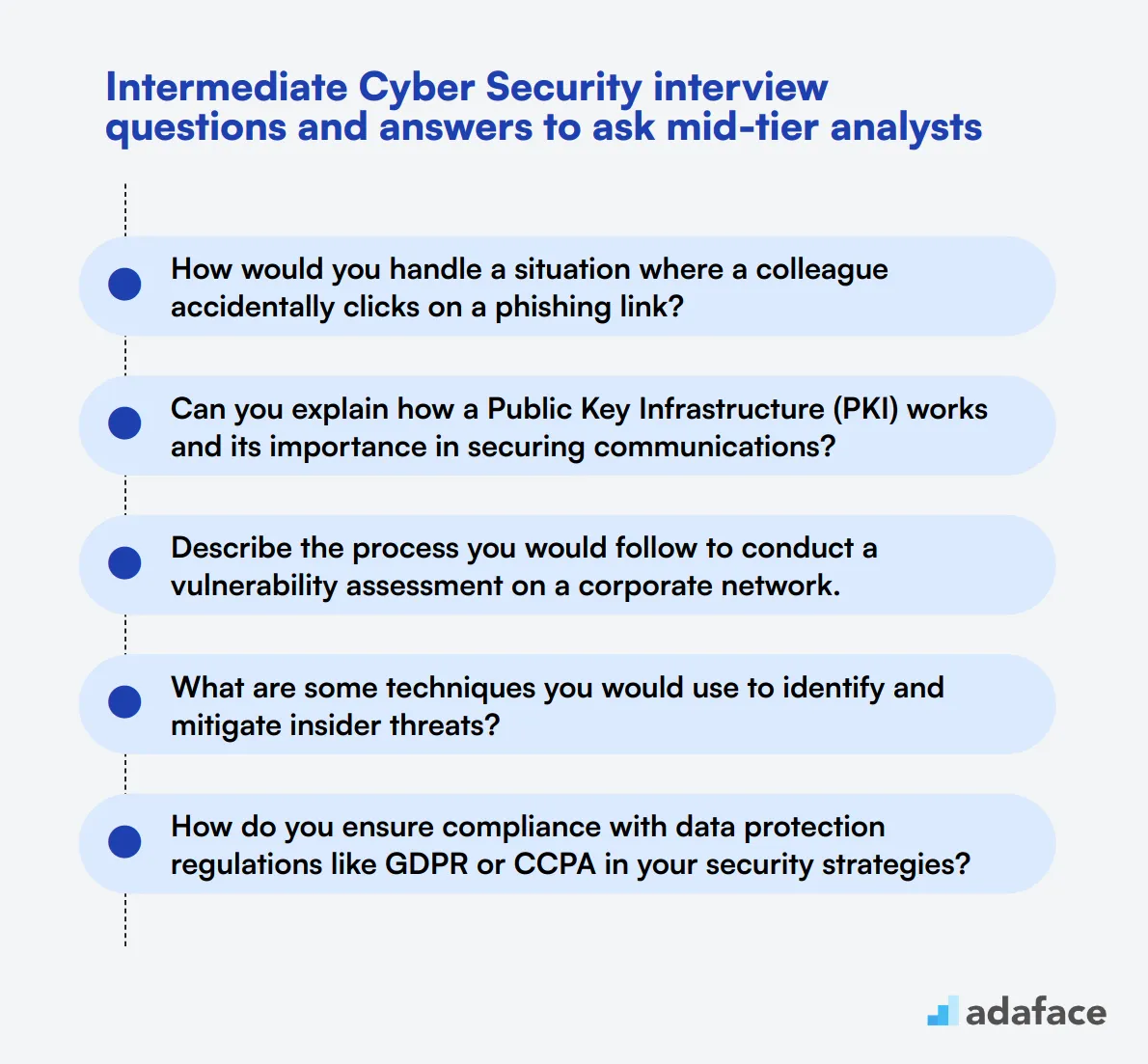
To ensure your mid-tier cyber security hires are capable of handling intermediate-level challenges, it's crucial to ask the right questions during the interview process. Use these 18 questions to gauge their technical skills, practical experience, and situational judgment. For a comprehensive understanding of the role requirements, you can refer to this cyber security analyst job description.
- How would you handle a situation where a colleague accidentally clicks on a phishing link?
- Can you explain how a Public Key Infrastructure (PKI) works and its importance in securing communications?
- Describe the process you would follow to conduct a vulnerability assessment on a corporate network.
- What are some techniques you would use to identify and mitigate insider threats?
- How do you ensure compliance with data protection regulations like GDPR or CCPA in your security strategies?
- Discuss your experience with implementing and managing Security Information and Event Management (SIEM) systems.
- What steps would you take to secure a cloud environment, such as AWS or Azure?
- Explain the importance of penetration testing and how it fits into a company's overall security posture.
- How do you handle and analyze security logs to identify unusual activity or potential threats?
- Describe a time when you had to respond to a security incident. What was your approach and the outcome?
- What is a man-in-the-middle attack and how can you prevent it?
- How do you prioritize security tasks and vulnerabilities when managing multiple projects?
- Can you explain what role machine learning and artificial intelligence play in modern cyber security?
- Describe your experience with network segmentation. Why is it important and how do you implement it?
- What are the key differences between threat, vulnerability, and risk?
- How do you approach creating and implementing a Disaster Recovery Plan (DRP) for an organization?
- What measures do you take to secure mobile devices within a corporate environment?
- How do you ensure that third-party vendors comply with your organization’s security policies and standards?
7 Cyber Security interview questions and answers related to threat mitigation techniques
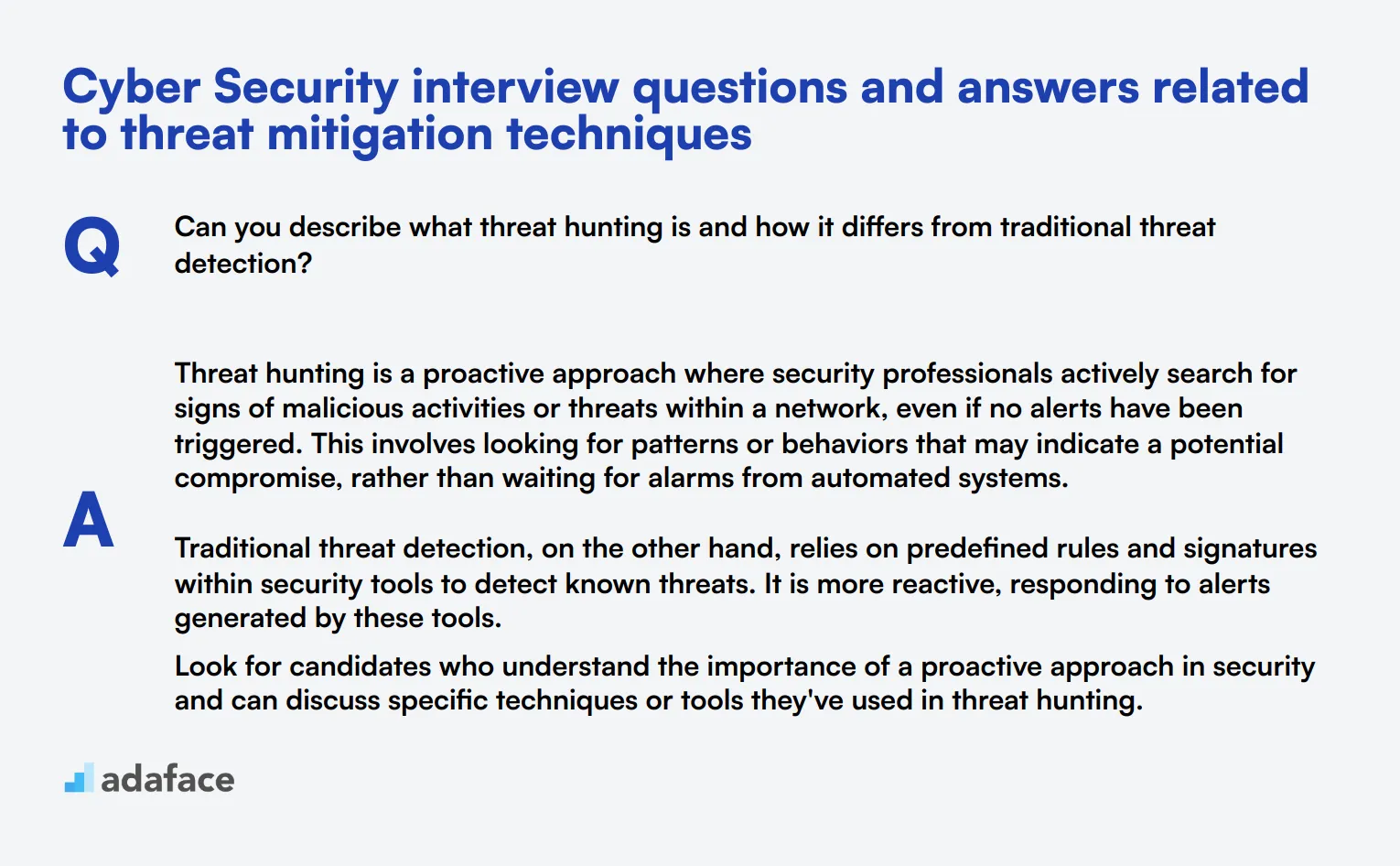
To assess whether your candidates have the right knowledge to protect your organization against cyber threats, ask them these key interview questions on threat mitigation techniques. These questions will help you gauge their practical understanding and readiness to handle real-world challenges.
1. Can you describe what threat hunting is and how it differs from traditional threat detection?
Threat hunting is a proactive approach where security professionals actively search for signs of malicious activities or threats within a network, even if no alerts have been triggered. This involves looking for patterns or behaviors that may indicate a potential compromise, rather than waiting for alarms from automated systems.
Traditional threat detection, on the other hand, relies on predefined rules and signatures within security tools to detect known threats. It is more reactive, responding to alerts generated by these tools.
Look for candidates who understand the importance of a proactive approach in security and can discuss specific techniques or tools they've used in threat hunting.
2. How do you approach creating and implementing security policies for an organization?
Creating and implementing security policies involves several steps: identifying the organization's assets and potential risks, defining clear security objectives, and drafting policies that align with these objectives. These policies should be practical, enforceable, and communicated clearly to all employees.
Implementation includes training employees, monitoring compliance, and regularly reviewing and updating the policies to adapt to new threats and changes in the organization.
An ideal candidate should mention the importance of stakeholder involvement, regular audits, and the need for continuous improvement in security policies.
3. Explain what network segmentation is and why it is important for threat mitigation.
Network segmentation involves dividing a network into smaller, isolated segments, each with its own security controls. This limits the spread of malware or unauthorized access within the network, as attackers cannot easily move laterally between segments.
It is important because it helps contain breaches and reduces the attack surface, making it harder for attackers to reach critical systems or sensitive data.
Candidates should highlight their experience with implementing network segmentation, the tools they used, and the benefits it brought to their previous organizations.
4. What are some common techniques for mitigating phishing attacks?
Common techniques for mitigating phishing attacks include employee training to recognize phishing attempts, implementing email filtering solutions to block suspicious messages, and using multi-factor authentication to add an extra layer of security.
Regular phishing simulations can also help employees stay vigilant and improve their ability to identify phishing attempts.
Strong candidates should mention a combination of technical measures and user education, emphasizing the importance of a well-rounded approach to mitigate phishing attacks.
5. How would you go about securing a remote workforce?
Securing a remote workforce involves several key steps: ensuring secure connections through VPNs, implementing multi-factor authentication, regularly updating and patching systems, and providing cybersecurity training to remote employees.
It's also important to enforce the use of secure devices and to monitor for unusual activities that may indicate security breaches.
Look for candidates who understand the unique challenges of remote work environments and can provide specific examples of measures they have implemented to secure remote teams.
6. Can you explain the concept of 'zero-day vulnerability' and how you would protect against it?
A zero-day vulnerability is a software flaw that is unknown to the software vendor and has no available patch or fix. Attackers can exploit these vulnerabilities before they are discovered and addressed by the vendor.
Protecting against zero-day vulnerabilities involves using advanced threat detection tools, implementing strong network security measures, and keeping systems and software as up-to-date as possible to reduce the attack surface.
Candidates should discuss their experience with tools and strategies for identifying and mitigating zero-day vulnerabilities, such as threat intelligence platforms and behavior-based detection systems.
7. What measures would you take to secure data stored in the cloud?
To secure data stored in the cloud, measures include encrypting data both at rest and in transit, using strong access controls and identity management, regularly auditing and monitoring cloud environments, and ensuring compliance with relevant security standards and regulations.
It's also important to work closely with cloud service providers to understand their security practices and to implement additional security layers as needed.
Candidates should demonstrate their knowledge of cloud security best practices and their ability to implement these measures effectively in a real-world environment.
12 Cyber Security interview questions about network security protocols
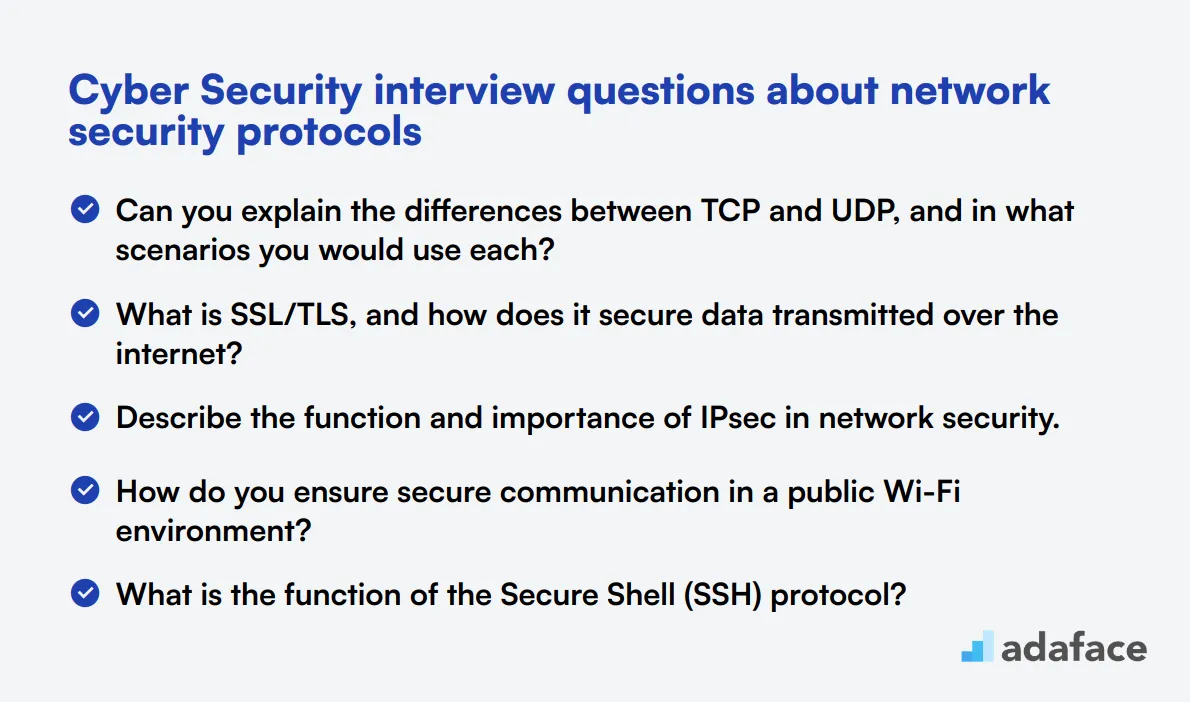
To evaluate a candidate's grasp of network security protocols, use these interview questions to delve into their technical knowledge and practical experience. Effective for roles such as Cyber Security Analysts and other security-focused positions, these questions help identify the best talent for your team.
- Can you explain the differences between TCP and UDP, and in what scenarios you would use each?
- What is SSL/TLS, and how does it secure data transmitted over the internet?
- Describe the function and importance of IPsec in network security.
- How do you ensure secure communication in a public Wi-Fi environment?
- What is the function of the Secure Shell (SSH) protocol?
- Can you explain the differences between HTTPS and HTTP, and why HTTPS is preferred?
- What are the main security features of the DNSSEC protocol?
- How does the Simple Network Management Protocol (SNMP) impact network security?
- What is a VPN protocol, and which ones would you recommend for secure communication?
- Explain what Transport Layer Security (TLS) certificates are and how they work.
- What role does the Kerberos protocol play in network security?
- Can you describe what the Security Association (SA) is in the context of IPsec?
10 situational Cyber Security interview questions for hiring top analysts
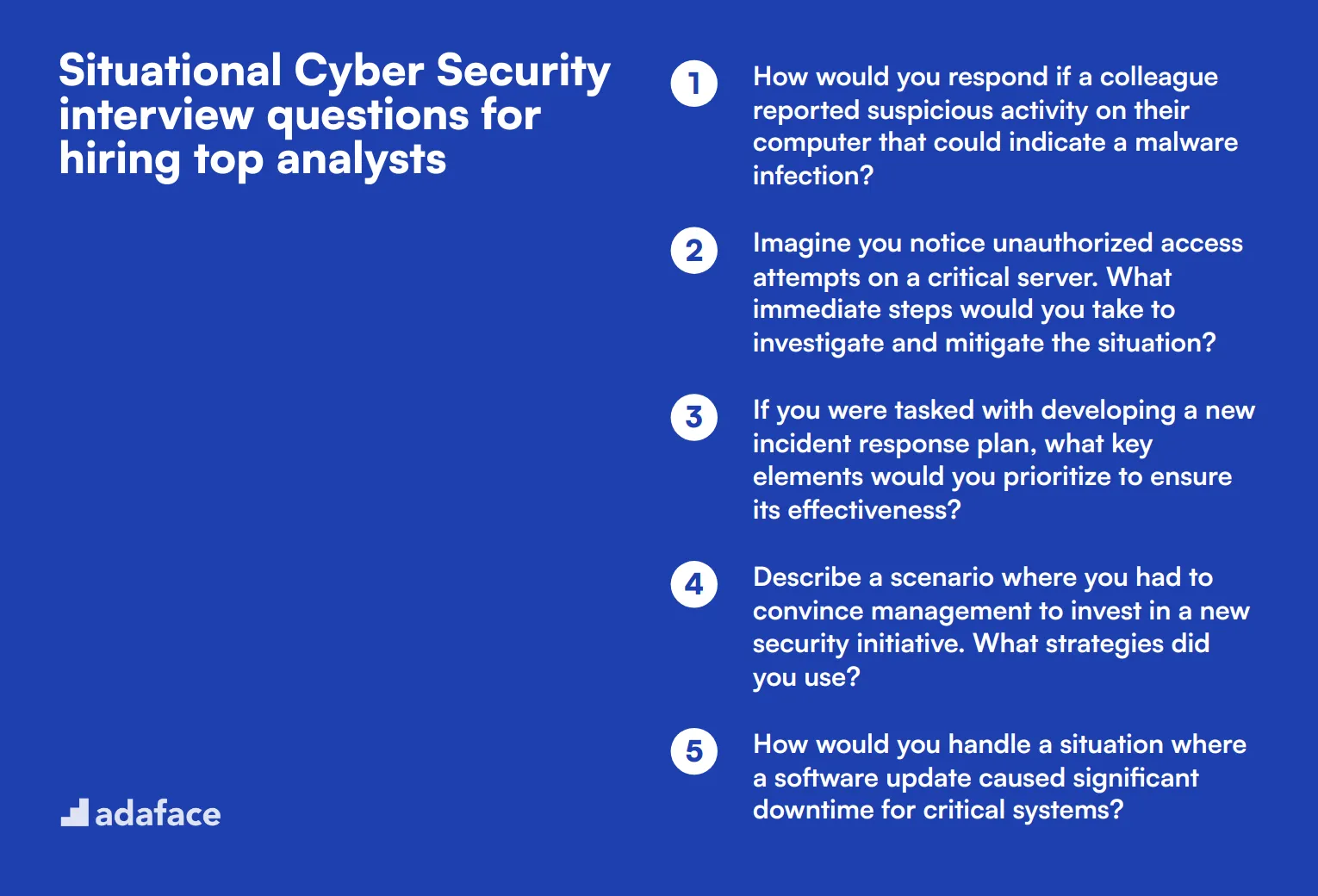
To find the best cyber security analysts, it's crucial to ask situational questions that reveal their problem-solving skills and practical knowledge. Use this list of questions during interviews to assess candidates' abilities to handle real-world security challenges effectively, ensuring they meet your organization's needs for roles like cyber security analyst.
- How would you respond if a colleague reported suspicious activity on their computer that could indicate a malware infection?
- Imagine you notice unauthorized access attempts on a critical server. What immediate steps would you take to investigate and mitigate the situation?
- If you were tasked with developing a new incident response plan, what key elements would you prioritize to ensure its effectiveness?
- Describe a scenario where you had to convince management to invest in a new security initiative. What strategies did you use?
- How would you handle a situation where a software update caused significant downtime for critical systems?
- If you were leading a team dealing with a ransomware attack, what actions would you take to manage the crisis and communicate with affected stakeholders?
- What approach would you take to assess the security posture of a third-party vendor before entering into a partnership?
- If you discovered a major vulnerability in a widely used application, how would you decide whether to disclose it publicly or keep it confidential?
- Imagine you are asked to conduct a security training session for non-technical employees. What topics would you include to make it engaging and informative?
- How would you prioritize remediation efforts if multiple vulnerabilities were discovered in various systems at the same time?
Which Cyber Security skills should you evaluate during the interview phase?
Evaluating a candidate's Cyber Security skills in a single interview can be challenging, as it doesn't allow for a comprehensive assessment of their expertise. However, focusing on key skills can provide valuable insights into a candidate's suitability for the role. Here are the essential skills to consider during the interview phase.
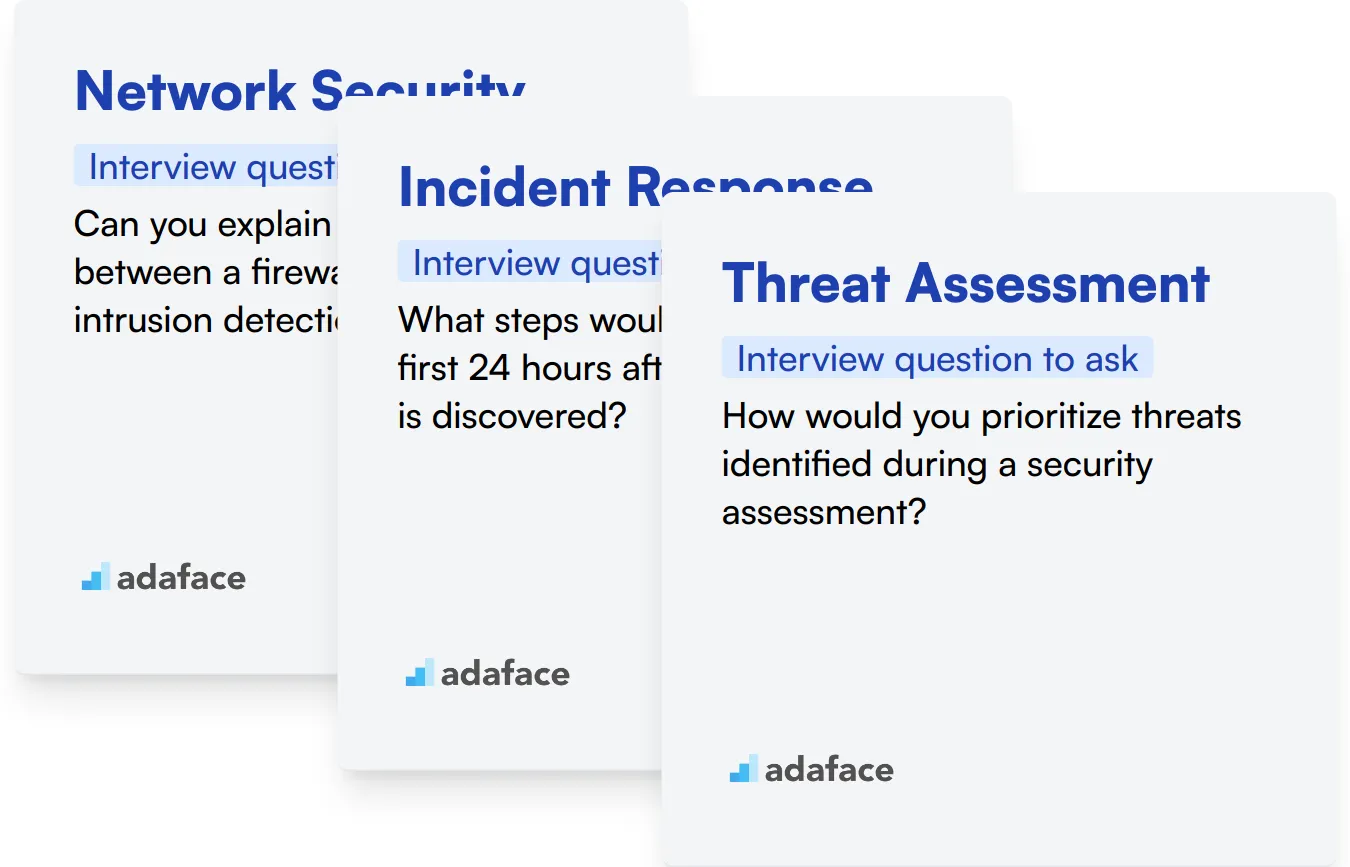
Network Security
To assess a candidate's knowledge in network security, consider using an assessment test that includes relevant multiple-choice questions. Our network engineer test is designed to evaluate candidates on this skill effectively.
You can also ask targeted interview questions to further gauge their network security understanding. One question that can help assess this is:
Can you explain the differences between a firewall and an intrusion detection system (IDS)?
When posing this question, look for an explanation that clearly differentiates between a firewall's role in blocking unauthorized access and an IDS's function in monitoring for suspicious activity. A well-versed candidate should elicit specific examples of when to use each.
Incident Response
Utilizing an assessment test that focuses on incident response can be beneficial. Our cyber security test includes questions relevant to this skill and can help filter candidates effectively.
To further evaluate this skill, consider asking candidates:
What steps would you take in the first 24 hours after a data breach is discovered?
When asking this question, pay attention to their understanding of containment, eradication, and recovery steps. Ideal candidates should demonstrate a structured approach and awareness of communication strategies following an incident.
Threat Assessment
You may want to use an assessment test that evaluates a candidate's threat assessment abilities. Our cyber security test includes relevant questions that can help measure this skill.
To further explore their capabilities, ask:
How would you prioritize threats identified during a security assessment?
Look for a response that showcases an understanding of risk management principles, such as evaluating likelihood versus impact. Their answer should reflect an analytical mindset tailored to your organization's priorities.
Streamline Your Hiring with Cyber Security Skills Tests and Targeted Interview Questions
If you're in the process of hiring a Cyber Security expert, it's important to verify that candidates possess the necessary skills. Ensuring skill proficiency early in the hiring process saves time and resources.
One of the best ways to assess these skills is through targeted skill tests. Consider using our Cyber Security Test or Network Engineer Test to accurately evaluate the technical abilities of your candidates.
After administering these tests, you can effectively shortlist the top candidates. This refined pool can then be invited for interviews, where you can explore their skills and fit for your team in greater depth.
Ready to enhance your hiring process? Get started by signing up for an account or learn more about our offerings on our Online Assessment Platform page.
Cyber Security Assessment Test
Download Cyber Security interview questions template in multiple formats
Cyber Security Interview Questions FAQs
Ask a mix of basic, junior, intermediate, and situational questions covering threat mitigation, network security protocols, and practical scenarios.
Use situational questions and ask about specific techniques, tools, and experiences related to real-world security challenges.
Focus on threat detection, network security, incident response, risk assessment, and knowledge of current security trends and technologies.
Present hypothetical security scenarios and ask candidates to explain their approach to resolving the issues step-by-step.
Skills tests provide objective data on a candidate's technical abilities, complementing interview questions for a more thorough evaluation.

40 min skill tests.
No trick questions.
Accurate shortlisting.
We make it easy for you to find the best candidates in your pipeline with a 40 min skills test.
Try for freeRelated posts
Free resources




